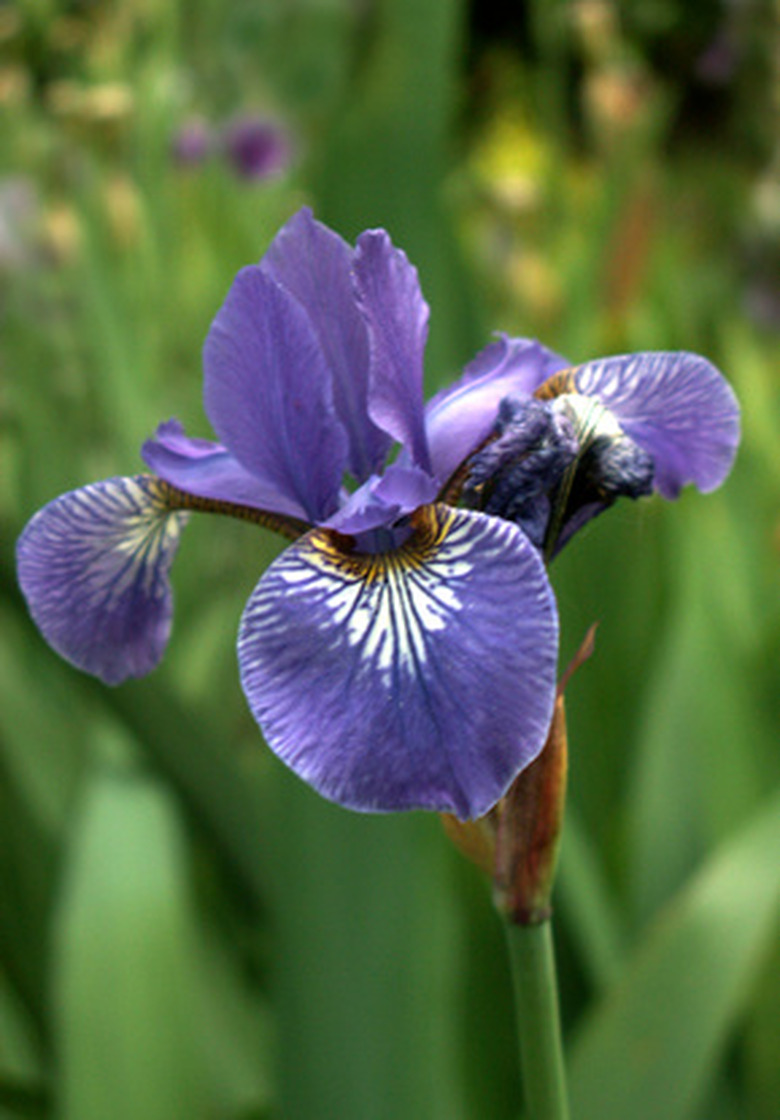Comparison Of Japanese Iris Foliage & Siberian Iris Foliage
Besides bearded irises, gardeners across U.S. Department of Agriculture hardiness zones 3 through 9 also grow Japanese irises (Iris ensata/Iris kaempferi) and Siberian irises (Iris sibirica). Both of these herbaceous perennials grow from fleshy rhizomes and prosper in a sunny location with a slightly acidic, moist soil. While Siberian types bloom a bit earlier in early summer, Japanese irises tend to produce larger flowers. Both types include a wide array of cultivars with different flower color choices.
Features
Both Japanese and Siberian irises' foliage is held upright and resembles a wide-bladed clump of grass. They are sword-shaped and linear. The leaves don't resemble the equitant fanned leaves of the common bearded iris at all. In the center of Japanese iris leaves you can see a prominent midrib vein.
- Besides bearded irises, gardeners across U.S. Department of Agriculture hardiness zones 3 through 9 also grow Japanese irises (Iris ensata/Iris kaempferi) and Siberian irises (Iris sibirica).
- Both Japanese and Siberian irises' foliage is held upright and resembles a wide-bladed clump of grass.
Color
Both species of irises produce lush jade to kelly green foliage when healthfully growing in moist, fertile soils. In shifting daylight, Siberian iris leaves may reveal a slight bluish green cast.
Size
University of Georgia perennial plant expert Allan Armitage notes that Japanese iris leaves mature anywhere from 24 to 30 inches tall and a clump of foliage and rhizomes spread to 24 inches in width. He then comments that Siberian irises from 24 to 36 inches tall, and 24 inches wide. Also reflecting the taller tendency of Siberian irises is the "A-Z Encyclopedia of Garden Plants" from the American Horticultural Society. This book states Japanese iris grows to 36 inches tall and Siberian types up to 48 inches tall.
Habit
Overall, there is a tendency for the tips of Japanese iris leaves to gently flop over gracefully, unlike the more erect mature Siberian iris. Keep in mind with the scores of different cultivars, there may be genetic dwarf or other genetically variant selections that do not display consistent characteristics of the wild species.
- Both species of irises produce lush jade to kelly green foliage when healthfully growing in moist, fertile soils.
- Overall, there is a tendency for the tips of Japanese iris leaves to gently flop over gracefully, unlike the more erect mature Siberian iris.
Considerations
Siberian iris plants are much more needing of a wet soil and if soil conditions are too dry, the foliage tips often yellow and brown. If soils are nutritionally poor or high in pH (alkaline), the leaves overall become lighter green with streaks of yellow. Japanese iris is more tolerant of upland, average garden soils that remain moist. Excessive dryness can also cause premature yellowing of leaves as will alkaline ground. In warm winter areas where frost is rare, the foliage of Japanese iris may persist as nearly evergreen and look rather ragged and yellow-tan on tips from winter chill.
References
- Missouri Botanical Garden: Iris ensata
- "Herbaceous Perennial Plants"; Allan M. Armitage; 1989
- "A-Z Encyclopedia of Garden Plants"; Christopher Brickell and H. Marc Cathey, eds.; 2004
